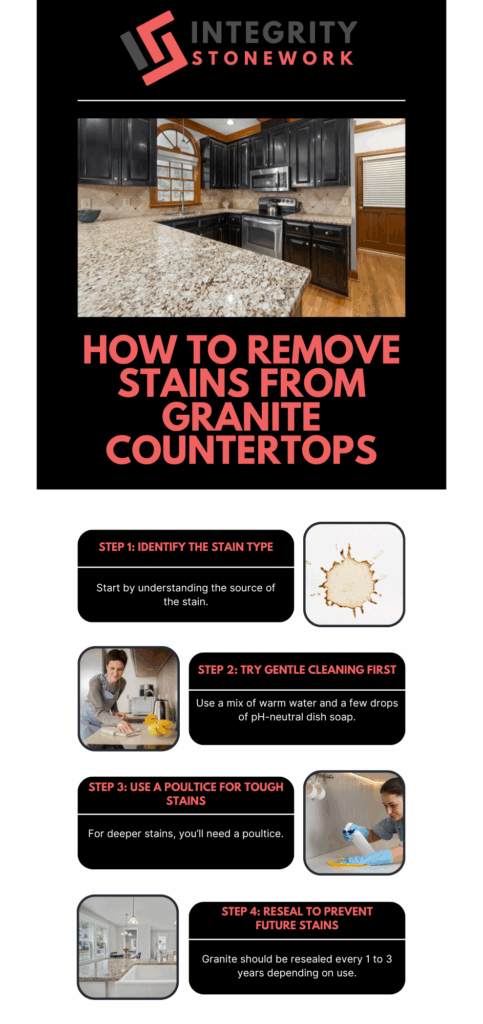How to Remove Stains from Granite, Quartz, and Marble: A Guide from Your Trusted Countertops Experts

Countertops aren’t just functional surfaces—they’re foundational to how we cook, gather, and express style in our homes and workspaces. At Integrity Stonework, we understand that your granite, quartz, and marble countertops are meaningful investments. When stains appear—whether from red wine, oil splashes, or ink marks—they can feel like blemishes on something you’ve worked hard to maintain.
In this detailed guide, our team of countertops experts will walk you through how to identify and remove common stains from these three types of surfaces—safely and effectively. Whether you’re cleaning up after a dinner party or tackling a long-standing mark, we’ll help you do it with confidence and care.
Understanding the Nature of Stone: Why Stains Happen
Before you dive into stain removal, it’s essential to understand how granite, quartz, and marble differ in their composition—and why that matters.
Granite
Granite is a natural stone that’s extremely durable but still porous. This means it can absorb liquids if not properly sealed, resulting in stains from oils, food, or metal.
Quartz
Quartz is an engineered surface made from crushed stone held together by resin. Though it’s non-porous and more stain-resistant, strong dyes and harsh chemicals can still cause staining or surface damage over time.
Marble
Marble is a soft, porous natural stone that’s beautiful but more vulnerable to staining and etching—especially from acidic foods and beverages like lemon juice or wine.
Knowing the specific vulnerabilities of your countertop material helps ensure you use the right tools and techniques—not just to clean the stain, but to protect your surface from further harm.

How to Remove Stains from Granite Countertops
Granite is built to last, but it’s not immune to everyday mishaps. Here’s how to tackle stains on granite while preserving its signature strength and shine.
Step 1: Identify the Stain Type
Start by understanding the source of the stain:
- Oil-based: Dark, greasy-looking areas (cooking oils, cosmetics)
- Organic: Brown, pink, or red discoloration (coffee, fruit, tea)
- Rust: Orange or reddish spots (metal cookware, cans)
- Ink or dye: Strong-colored marks (pens, markers)
Step 2: Try Gentle Cleaning First
Use a mix of warm water and a few drops of pH-neutral dish soap. Avoid abrasive cleaners or anything acidic. Wipe with a soft cloth or sponge and dry with a microfiber towel.
Step 3: Use a Poultice for Tough Stains
For deeper stains, you’ll need a poultice—a paste that draws the stain out of the stone.
DIY Poultice Recipe for Granite:
- 1 cup baking soda
- Water (or hydrogen peroxide for organic stains)
- Plastic wrap and masking tape
Apply a ¼-inch layer of the poultice over the stain. Cover it with plastic wrap and tape it down. Let it sit for 24 to 48 hours. Then remove the wrap, scrape off the paste with a plastic spatula, and wipe clean. You may need to repeat the process for stubborn stains.
For rust stains, use a specialty rust remover specifically labeled safe for natural stone—never general-purpose cleaners.
Step 4: Reseal to Prevent Future Stains
Granite should be resealed every 1 to 3 years depending on use. Test your surface by placing a few drops of water on it. If the water darkens the stone in under 10 minutes, it’s time to reseal.
Explore Our Granite Services
How to Remove Stains from Quartz Countertops
Quartz is known for its durability, but it still needs care when it comes to stains from food dyes, inks, or grease.
Step 1: Start with Gentle Cleaners
Wipe the surface with a mix of warm water and mild dish soap using a soft cloth. Avoid scrubbing too hard or using any abrasives.
Step 2: Tackle Specific Stains
- Ink and dye stains: Dab a cotton ball in isopropyl alcohol and gently rub the stained area. For stubborn spots, a magic eraser may help—test it first on an inconspicuous area.
- Grease stains: Make a paste of baking soda and water, let it sit for 5–10 minutes, then wipe clean.
Avoid the following cleaners:
- Bleach
- Oven cleaner
- Acetone
- Anything with high pH or acidic ingredients
These can degrade the resins that bind quartz, leading to discoloration or dullness.
Step 3: Prevention Tips
- Always use cutting boards and trivets.
- Clean spills immediately, especially wine, tomato sauce, or strong dyes.
- Avoid letting metal containers sit directly on damp areas.
Check Out Our Quartz Countertop Solutions
How to Remove Stains from Marble Countertops
Marble is elegant and luxurious—but requires gentle, informed care when it comes to stain removal.
Step 1: Blot, Don’t Rub
If a spill happens, blot it immediately with a paper towel or soft cloth. Rubbing can spread the stain and grind it into the surface.
Step 2: Match Cleaner to Stain
- Organic stains (coffee, wine, fruit): Use a mix of 12% hydrogen peroxide and a drop of ammonia. Apply gently using a white cloth.
- Oil-based stains (grease, butter): Dab with a cloth soaked in acetone (test first and avoid excessive rubbing).
- Etching (from acidic food): Use a marble polishing powder, not a cleaner. These spots require physical buffing to restore the shine.
Step 3: Poultice Application
Just like with granite, apply a poultice made of baking soda and water over the stain. Cover it, let it dry, then remove and wipe clean. This method is especially effective on old or stubborn marks.
Step 4: Ongoing Maintenance
Marble should be sealed at least once a year. Some high-use areas (like kitchen islands) may need more frequent treatment.
Learn More About Marble Maintenance
Prevention: Your First Line of Defense Against Stains
Preventing stains is easier—and often more effective—than removing them. Here’s how to safeguard your surfaces long-term:
- Seal regularly: Especially with granite and marble. Follow manufacturer or installer guidance.
- Use coasters, cutting boards, and trivets: Keep wine glasses, hot pans, and oils off the bare surface.
- Avoid harsh chemicals: Especially anything acidic or bleach-based.
- Clean spills right away: The sooner, the better. Don’t give the stain a chance to soak in.
- Use stone-safe cleaners: Stick to pH-neutral, stone-specific products.
When to Call Your Local Countertops Experts
Some stains need more than elbow grease. If you’ve tried poultices, specialty cleaners, and polishing products with little to no success, don’t risk damaging your countertops further.
At Integrity Stonework, we offer more than high-quality stone surfaces. We provide expert care, practical guidance, and professional insight that helps extend the life and beauty of your investment. If you’re searching for countertops experts near me, our local team is just a message away—ready to help with care, professionalism, and integrity.
Request Help from the Integrity Stonework Team
Conclusion: Learn More with Integrity Stonework
Stains happen, but they don’t have to leave a lasting mark. With the right approach and the right partner, you can enjoy stunning countertops that look as good as the day they were installed.
Whether you’re cleaning, repairing, or upgrading, Integrity Stonework is here to help—because we believe in long-term relationships, built on trust, quality, and care.
Learn More About Our Countertop Services
FAQs
Can I use vinegar or bleach to clean stone countertops?
No. Both vinegar and bleach are too harsh and can damage sealants or resin binders in granite, quartz, and marble surfaces.
How do I know if my countertop needs sealing?
Place a few drops of water on the surface. If it darkens in under 10 minutes, your countertop needs resealing.
What’s the difference between a stain and an etch mark?
A stain is a discoloration caused by a substance soaking into the stone. Etching is a dull spot caused by acid reaction—common with marble—requiring polishing, not cleaning.
For more expert tips and support from your trusted countertops experts, stay connected with us at Integrity Stonework. We’re here to help your countertops look their best—every day.
